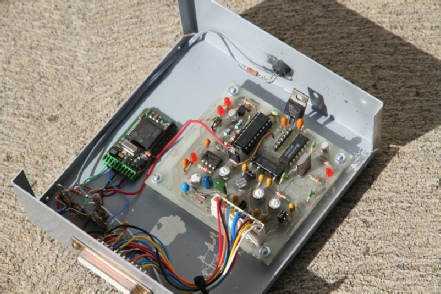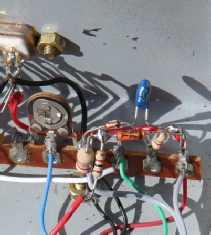

J.F.Drew © 2000-2017






Mobile menus
VK5DJ
Solar power repeater controller

“Necessity is the mother of invention” is often heard and this was the case when our radio club (South East Radio Group) decided for access reasons to move its UHF repeater to another site .
Although the owners of the site were happy to provide access to power we did not want to abuse their kindness in offering the site, an abandoned water tower to the North of Mount Gambier. As we had access to the roof the club decided to go solar.
The repeater on 439.825 output links to our IRLP repeater some 50km away so as well as powering the PRF1520 TX/RX on 70cm it also powers the link TX/RX, a PRM80.
The club approved the purchase of two 120 watt panels as a result of calculations that suggested the current level of use the solar arrangement should be sufficient to power the repeater and its link.
It was difficult to accurately calculate the power budget as the usage of the repeater varies wildly and of course we are in the cloudy corner of the state. There will be days when charge may be quite low, although experience has proven otherwise.
Deep discharge batteries are expensive so it was decided that we should have a means of monitoring the voltage of the batteries and a method of inhibiting transmissions.
And so another version of my repeater controller software was developed - or more correctly, another patch added.
The added code consists of a command to activate or de-activate the telemetry, a means of remotely setting the points at which the main TX was silenced and a point at which the link was silenced. Both receivers remain on at all times.
The new commands are:
<pwd> 02 20 telemetry on
<pwd> 11 XX where XX is the HEX value for the voltage (for example 11.5V = 115 Dec = 73 HEX) for Main TX off
<pwd> 12 YY where YY is the HEX value for the voltage (for example 11.8V = 118 Dec = 76 HEX) for Link TX off
The telemetry is made up of 3 tones: Low = 200Hz, medium = 500Hz, high = 1430Hz
The table is shown in the new manual but as an example High/High/Low = 13.8 volts
Once people have a copy of the table anyone can identify the current voltage at the controller. Voltage drops in leads need to be considered when setting TX cutoffs.
Lock out of transmitters
Because solar power is a little unpredictable, the controller will switch off the transmitters at the voltage set in commands 11 and 12. They will not restart until the voltage rises 1 volt above the cutoff voltage to enable battery recharge.
How does it work?
The PIC16F1827 has a number of A/D converters. I had to do a little reshuffle of the pins to access one of the A/D ports on pin 7.
The A/D converter can only work for a voltage from 0-5V. Therefore 10 volts has to be subtracted from the voltage to be measured to keep the volts within 0-5 range. This is done using a zener to subtract 10V. The telemetry is set to read <=11.4V, then every 0.1V until 14.0V when no further attempt is made to send telemetry.
I have not put the files on the Download page as it is not an official release yet, but here are the files I’m using for VK5ROH for anyone who wants to experiment (the password is 973).


This controller for VK5ROH is my Mk l version with a handdrawn PCB. So it looks a little different from the new boards. It makes use of an external CTCSS decoder (left)
The important thing to notice is that a new wire has been added between pin 16 and a pin of JP3. A decision has to be made which CTCSS is to be used (internal or external) and a wire joins this to pin 16.
The common two pins of JP3 now become the voltage input (0-5V). See the last appendix in my manual for further information. I used a header to slip over JP3 so that in the event the board needed to be removed the header could be unplugged.
To the right is a photo showing the voltage subtraction section - external to the board.
The tag strip supported components for setting levels to the external CTCSS decoder. The tag strip proved useful to install the top of the zener to +supply, the bottom of the zener through a 220 ohm resistor to earth. The voltage feed to be measured is taken via a 1K resistor from the junction of the zener and the 220 ohm resistor.
See my manual for information on how this is used and calibrated.
This version of the repeater project has been working well at the new site.
| Repeater features |
| Solar version |
| 1750Hz decoder |
| Record and playback |
| Voice interface |
| Micor solution |
| Yagi Calculator |
| RD Contest logger |
| Moon Tracking |
| Orbitron interface |
| PRFCalc |
| TAIT programming |
| Proton Development Suite |
| Old crystals for radios |
| Compound interest |
| Yagi photos |
| Bird proofing |
| Bender |
| VK5DJ downloads |
| VK3UM downloads |
| Site map |